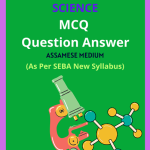Class 8 Science MCQ Chapter 9 Reproduction in Animals Solutions in English Medium, Class 8 Science Multiple Choice Question Answer in English to each chapter is provided in the list so that you can easily browse throughout different chapters Class 8 Science MCQ Chapter 9 Reproduction in Animals Notes and select need one.
Class 8 Science MCQ Chapter 9 Reproduction in Animals
Also, you can read the SCERT book online in these sections Class 8 Science Objective Type Solutions by Expert Teachers as per SCERT (CBSE) Book guidelines. These solutions are part of SCERT All Subject Solutions. Here we have given Assam Class 8 Science MCQs Solutions in English for All Subject, You can practice these here.
Reproduction in Animals
Chapter – 9
| MCQ |
1. Which of the following is an example of asexual reproduction?
(a) Binary fission.
(b) External fertilization.
(c) Internal fertilization.
(d) Sexual reproduction.
Ans: (a) Binary fission.
2. In which type of reproduction does an organism split into two or more parts, each of which can develop into a new individual?
(a) Budding.
(b) Fragmentation.
(c) Binary fission.
(d) Parthenogenesis.
Ans: (b) Fragmentation.
3. What is the main advantage of asexual reproduction?
(a) Genetic diversity.
(b) Rapid population growth.
(c) Requires two parents.
(d) Involves complex processes.
Ans: (b) Rapid population growth.
4. Which process involves the development of an egg without fertilization?
(a) Binary fission.
(b) Budding.
(c) Parthenogenesis.
(d) Fragmentation.
Ans: (c) Parthenogenesis.
5. Which of the following animals uses external fertilization?
(a) Mammals.
(b) Birds.
(c) Reptiles.
(d) Most fish.
Ans: (d) Most fish.
6. In which type of reproduction does the egg develop inside the mother’s body?
(a) Oviparous.
(b) Viviparous.
(c) Ovoviviparous.
(d) Asexual.
Ans: (b) Viviparous.
7. What is the term for animals that lay eggs and do not provide further nourishment to the developing embryos?
(a) Viviparous.
(b) Oviparous.
(c) Ovoviviparous.
(d) Parthenogenetic.
Ans: (b) Oviparous.
8. Which of the following is an example of a viviparous animal?
(a) Frog.
(b) Chicken.
(c) Human.
(d) Turtle.
Ans: (c) Human.
9. Which type of reproduction occurs in hydras?
(a) Binary fission.
(b) Budding.
(c) Fragmentation.
(d) Parthenogenesis.
Ans: (b) Budding.
10. Which type of reproduction is characterized by the fusion of male and female gametes?
(a) Asexual reproduction.
(b) Sexual reproduction.
(c) Binary fission.
(d) Budding.
Ans: (b) Sexual reproduction.
11. What type of reproduction do starfish use to regenerate lost body parts?
(a) Binary fission.
(b) Budding.
(c) Fragmentation.
(d) Parthenogenesis.
Ans: (c) Fragmentation.
12. Which of the following animals is ovoviviparous?
(a) Shark.
(b) Kangaroo.
(c) Penguin.
(d) Chicken.
Ans: (a) Shark.
13. In which type of fertilization do sperm and egg meet inside the female’s body?
(a) External fertilization.
(b) Internal fertilization.
(c) Asexual reproduction.
(d) Parthenogenesis.
Ans: (b) Internal fertilization.
14. Which term describes animals that give live birth and have direct nourishment from the mother?
(a) Ovoviviparous.
(b) Oviparous.
(c) Viviparous.
(d) Budding.
Ans: (c) Viviparous.
15. Which reproductive strategy is used by organisms that do not need a mate?
(a) Sexual reproduction.
(b) Asexual reproduction.
(c) Internal fertilization.
(d) External fertilization.
Ans: (b) Asexual reproduction.

Hi! my Name is Parimal Roy. I have completed my Bachelor’s degree in Philosophy (B.A.) from Silapathar General College. Currently, I am working as an HR Manager at Dev Library. It is a website that provides study materials for students from Class 3 to 12, including SCERT and NCERT notes. It also offers resources for BA, B.Com, B.Sc, and Computer Science, along with postgraduate notes. Besides study materials, the website has novels, eBooks, health and finance articles, biographies, quotes, and more.




